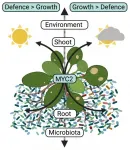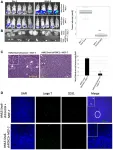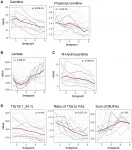Global BECCS potential is largely constrained by sustainable irrigation
2021-07-05
(Press-News.org) A new collaborative research led by researchers from the National Institute for Environmental Studies, Potsdam Institute for Climate Impact Research, Ritsumeikan University, and Kyoto University found that although unlimited irrigation could increase global BECCS potential (via the increase of bioenergy production) by 60-71% by the end of this century, sustainably constrained irrigation would increase it by only 5-6%. The study has been published in Nature Sustainability on July 5.
Bioenergy with carbon capture and storage (BECCS) is a process of extracting bioenergy from biomass, then capturing and storing the carbon to a geological reservoir. It is a negative emission technology since the biomass is produced by plants through photosynthesis that can uptake the carbon dioxide from atmosphere. To achieve the 2°C or 1.5°C climate goal, large-scale deployment of BECCS was assumed to be prominent in many previous studies. However, this caused increasing concerns on the challenges brought to water and land resources to grow the bioenergy crops. For example, existing studies have showed that irrigation to achieve considerable bioenergy crop production needed for BECCS potential comparable to the requirement of 2°C or 1.5°C climate goal would lead to severe water stress even than climate change itself.
Under this context, where and to what extent irrigation can enhance the global BECCS potential remains unknown under sustainable water use. "Here, we define it as water use securing the local and downstream water availability for conventional water use and environmental flow requirements, suppressing nonrenewable water resources withdrawal, and preventing additional water stress." explains lead author Zhipin Ai from National institute for environmental studies, Japan.
The study was based on simulations with a spatially explicit representation of bioenergy crop plantations and water cycle in an internally consistent model framework. To quantitatively determine the constraints of irrigation water resources, the researchers designed distinct irrigation ways (unlimited irrigation, sustainable irrigation, and no irrigation) with bioenergy crops planted on land scenarios with strict land protections to prevent adverse effects on biodiversity, food production, land degradation, and desertification due to large-scale land conversion.
The study found that, under the rain fed condition, the average global BECCS potential in 2090 was 0.82-1.99 Gt C yr-1. The BECCS potential reached 1.32-3.42 Gt C yr-1 (60% and 71% increases compared to that under rainfed condition) under full irrigation, whereas under sustainable irrigation, the BECCS potential was 0.88-2.09 Gt C yr-1 (5% and 6% increases compared to that under rainfed condition). The BECCS potential under sustainable irrigation is close to the lower limit of 1.6-4.1 Gt C yr-1, which is the required amount of BECCS in 2100 that consistent with the 1.5°C or 2°C climate goal as documented in the IPCC Special Report on Global Warming of 1.5ºC.
Given the many negative environmental impacts of large-scale deployment of BECCS, the researchers suggest that comprehensive assessments of the BECCS potential that consider both potential benefits and adverse effects are necessary for simultaneously achieving the multiple sustainable development goals on climate, water, land, etc. "In addition, considering the relatively low biophysically constrained BECCS potential under sustainable water and land use scenarios, a critical reexamination of the contribution of BECCS towards achieving the Paris Agreement goal is needed." says co-author Vera Heck from the Potsdam Institute for Climate Impact Research.
INFORMATION:
This study was supported by the Environment Research and Technology Development Fund (JPMEERF20202005, JPMEERF15S11418, and JPMEERF20211001) of the Environmental Restoration and Conservation Agency of Japan.
ELSE PRESS RELEASES FROM THIS DATE:
2021-07-05
"The number of black holes is roughly three times larger than expected from the number of stars in the cluster, and it means that more than 20% of the total cluster mass is made up of black holes. They each have a mass of about 20 times the mass of the Sun, and they formed in supernova explosions at the end of the lives of massive stars, when the cluster was still very young" says Prof Mark Gieles, from the Institute of Cosmos Sciences of the University of Barcelona (ICCUB) and lead author of the paper.
Tidal streams are streams of stars that were ejected from disrupting ...
2021-07-05
Land plants - plants that live primarily in terrestrial habitats and form vegetation on earth - are anchored to the ground through their roots, and their performance depends on both the belowground soil conditions and the aboveground climate. Plants utilize sunlight to grow through the process of photosynthesis where light energy is converted to chemical energy in chloroplasts, the powerhouses of plant cells. Therefore, the amount and quality of light perceived by chloroplasts through light absorbing pigments, such as chlorophyll, is a defining factor in plant growth and health. ...
2021-07-05
MADISON, Wis. -- About 100 additional wolves died over the winter in Wisconsin as a result of the delisting of grey wolves under the Endangered Species Act, alongside the 218 wolves killed by licensed hunters during Wisconsin's first public wolf hunt, according to new research.
The combined loss of 313 to 323 wolves represents a decline in the state's wolf population of between 27% and 33% between April 2020 and April 2021. Researchers estimate that a majority of these additional, uncounted deaths are due to something called cryptic poaching, where poachers hide evidence of illegal killings.
The findings are the first estimate of Wisconsin's wolf population since the public hunt in February, which ended early after hunters ...
2021-07-05
The theory that modern society is too clean, leading to defective immune systems in children, should be swept under the carpet, according to a new study by researchers at UCL and the London School of Hygiene & Tropical Medicine.
In medicine, the 'hygiene hypothesis' states that early childhood exposure to particular microorganisms protects against allergic diseases by contributing to the development of the immune system.
However, there is a pervading view (public narrative) that Western 21st century society is too hygienic, which means toddlers and children are likely to be less exposed to germs in early life and so become less resistant to allergies.
In this paper, published in the Journal of Allergy and Clinical Immunology, researchers point to four significant reasons which, ...
2021-07-05
Research published today has demonstrated the viability of 3D-printed tissue scaffolds that harmlessly degrade while promoting tissue regeneration following implantation.
The scaffolds showed highly promising tissue-healing performance, including the ability to support cell migration, the 'ingrowth' of tissues, and revascularisation (blood vessel growth).
Professor Andrew Dove, from the University of Birmingham's School of Chemistry, led the research group and is the lead author on the paper published in Nature Communications, which characterises the physical properties of the scaffolds, and explains how their 'shape memory' is key to promoting tissue regeneration. ...
2021-07-05
Flies have discriminating taste. Like a gourmet perusing a menu, they spend much of their time seeking sweet nutritious calories and avoiding bitter, potentially toxic food. But what happens in their brains when they make these food choices?
Yale researchers discovered an interesting way to find out. They tricked them.
In a study that could also help illuminate how people make food choices, the researchers gave hungry fruit flies the choice between sweet, nutritious food laced with bitter quinine and a less sweet, but not bitter, food containing fewer calories. Then, using neuroimaging, they tracked neural activity in their brains as they made these tough choices.
So which won? Calories or better taste?
"It depends on how hungry they are," said Michael Nitabach, professor of ...
2021-07-05
Researchers at Uppsala University have discovered lymph node-like structures close to the tumour in brain cancer patients, where immune cells can be activated to attack the tumour. They also found that immunotherapy enhanced the formation of these structures in a mouse model. This discovery suggests new opportunities to regulate the anti-tumour response of the immune system.
Glioma is a deadly brain tumour with a dismal prognosis. One reason why brain tumours are very hard to treat is that our immune system, which is designed to detect and destroy foreign ...
2021-07-05
Although most Canadians die from predictable causes and have health needs that can be met at home, only 20% of people receive a physician home visit in their last year of life.
To help understand the changing care needs of older adults as they age and when they might be nearing the end of their lives, a team of researchers developed the Risk Evaluation for Support: Predictions for Elder-Life in the Community Tool (RESPECT).
The calculator, which predicts death within 6 months, is based on data from more than 491 000 community-dwelling older adults who used home care in the 6-year period between 2007 and 2013.
"The RESPECT calculator allows families and their loved ...
2021-07-05
Oncotarget published "Carcinoma cells that have undergone an epithelial-mesenchymal transition differentiate into endothelial cells and contribute to tumor growth" which reported that the authors investigated whether EMT can confer endothelial attributes upon carcinoma cells, augmenting tumor growth and vascularization.
Hypoxic regions, demarcated by HIF-1α staining, exhibited focal areas of E-cadherin loss and elevated levels of vimentin and the EMT-mediator FOXC2. Implantation of MCF-7 cells, co-mixed with human mammary epithelial cells overexpressing the EMT-inducer Snail, markedly ...
2021-07-05
Oncotarget published "Perioperative changes in the plasma metabolome of patients receiving general anesthesia for pancreatic cancer surgery" which reported that little is known about the impact of anesthesia on the plasma metabolome, although many metabolites have been shown to modulate the function of various immune cells, making it particularly interesting in the context of oncological surgery.
In this study longitudinal dynamics in the plasma metabolome during general anesthesia in patients undergoing pancreatic surgery were analyzed.
Prospective, observational study with 10 patients diagnosed with pancreatic malignancy and subjected to elective resection surgery under general anesthesia.
Plasma metabolites were quantified at ...
LAST 30 PRESS RELEASES:
[Press-News.org] Global BECCS potential is largely constrained by sustainable irrigation


